
|
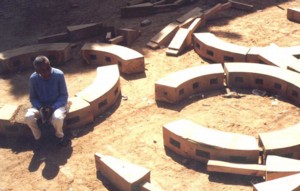
|
| Text and Context in Dialogue |

|

|
| Text and Context in Dialogue |
Sri Nivas has come!: the chariot festival of Bungadyah
by
Like a great ship staggering through a heavy sea - its curved prow terminating in a gilt figurehead of Bhairav, apparently forcing its way through the seething mass of humans who like billows surround it in one capacity and another - the great god Matsyendra in his car, with strain and cry makes his annual journey.
Percy Brown, Picturesque Nepal, p. 108-9
By far the most important festival of the hot season for Lalitpur (Patan) is the chariot festival of Bungadyah.[1] The image of Bungadyah is seen as a manifestation of the deity Karunamaya or Matsyendranath. On the fourth day of the waxing lunar fortnight of Vaishakh the procession of the chariots begins with the pulling of Bungadyah's chariot to Ga Bahah. This is the scene as it plays out:
Late in the afternoon a crowd of several thousand participants and onlookers gathers in Pulchok. Bungadyah's partner deity Cakwahdyah has already been installed on his chariot at Tangah Bahah just down the road from Lagankhel towards Mangah (Durbar Square) and pulled from there to the Pulchok stupa to await Bungadyah's chariot. Dhimay drum ensembles arrive from all over the city bringing a rising sense of excitement with their military-style drumming and clashing of cymbals.[2] The 18th century Capuchin monk Father Giuseppe described the scene wryly: "The inhabitants ... run about beating and playing upon every kind of instrument their country affords, which make an inconceivable noise."[3]
A space opens up in the crowd and men begin to dance. Horn blowers arrive and position themselves a little down the road to be at the head of the procession. After them the sword of the medieval king of Lalitpur Sri Nivas arrives with the Palton guard and band of flutes and drums. Officials of the Guthi Corporation climb onto the platform and place the sword, which is called Yala Juju (meaning the King of Lalitpur) in its seat of honour in front of Bungadyah. Next two Newar Brahmans climb aboard, station themselves in front of the platform and behind a richly brocaded cloth positioned at the rear of the forward beam, and don their new white turbans. Thick hawser ropes are dragged across the road and the young men take up the strain. Finally, amid much celebration, the director of the pullers climbs onto the front of the forward beam immediately behind the mask of Hayagriva Bhairava, and the pulling of the chariot begins.
It is impossible to convey the tremendous atmosphere of anticipation and excitement of this moment. The haulers make a few trial attempts by which the leader and the rope-haulers get a feel for the weight of the chariot and for the rhythm of yanking (for at first the chariot has to be jerked off its posts). Then the chariot starts to move with a deafening salute by the muskets of the Palton and great celebration by the crowds. After turning the chariot ninety degrees, the procession takes off down the road with this massive vehicle lumbering precariously through the vast company of devotees. The dhimay groups precede it, drumming and clashing the cymbals energetically. The chariot stops and the drums and cymbals lower the tempo to play a more measured rhythm. As the great vehicle jolts once again into action the percussionists switch once again to their ecstatic high-energy playing. Now the chariot hurtles towards the Pulchok stupa where Cakwahdyah's chariot is awaiting it - a scene described so memorably a century ago by Percy Brown, above.
The origins of the Jatra are shrouded in legend. According to the chronicle Gopalaraja Vamshavali, however, the Jatra was initiated during Narendra Deva's reign around 644-80 AD.[4] Some authors have conjectured that Bungadyah may have been a very old deity that was later identified as Karunamaya. The tradition of a drought as the occasion for the beginning of the Jatra is certainly old. There are several versions of the legend surrounding the origins of the Jatra (see side boxes).[5] The festival has clearly undergone considerable changes since its inception. Much of this happened under powerful kings in the seventeenth and eighteenth centuries. The most significant of these kings was the illustrious Sri Nivas Malla who reigned 1660-1684 AD.
|
The coming of Karunamaya One day Gorakhnath was tricked by the nagas into losing a bet. Gorakhnath's response is to use his power (siddhi) to bind the nagas at Mrigasthali near Pashupatinath causing no rain to fall for twelve years. After much investigation, King Narendra Deva's pandits discovered the cause of the drought, which had decimated the Valley. They advised him that the only way he would be able to get Gorakhnath to rise and release the nagas is if he can persuade his guru, Avalokiteshvara Karunamaya, to come from Kamuni in Assam. Narendra Deva set out with his learned acarya, Bandhudatta and a peasant named Rathancakra in order to bring Karunamaya to the Valley. Arriving at Kamuni they found Karunamaya living as the youngest son of the king of that place. They managed to trick the king to let him go but his mother prevented him from leaving. Departing to the city of Kamarup Bandhudatta used his Tantric power to cast a spell on the boy who was able to sneak out of the palace over the sleeping form of his mother. The demons (yakshas), which always seemed to be in alliance with the queen, snatched the boy away so that Bandhudatta had to call on the Four Bhairavas for help. Seeing the Four Bhairavas, the boy was released and was carried on a palanquin by the Bhairavas to Nepal. As they neared their destination, however, the yakshas again cast a spell causing the weight of four mountains to be brought down on the palanquin. The ever-resourceful Bandhudatta overcame this with his own spell, which turned Karunamaya into a bumblebee. The bee flew into a Flask (kalasha) which was then covered and brought safely to the outlying village of Bunga by the Bhairavas. On hearing of his guru's arrival in the Valley Gorakhnath rose from his seat releasing the nagas and bringing rainfall once again to the parched fields. |
How Karunamaya ended up in Lalitpur A dispute then arose as to where the deity should be kept. Narendra Deva would have preferred to build a temple in his capital of Bhaktapur, Bandhudatta insisted that it should be built in his city of Kantipur [Kathmandu] but the farmer Rathancakra wanted it to be built in Lalitpur. So they summoned an old man of Lalitpur to decide the issue. The king of Lalitpur tricked the man into choosing his city even though he would have preferred it to be built in Bhaktapur. On pronouncing his judgement the old man dropped dead because of his dishonesty but the judgement had been made and could not be changed. The flask was taken to a monastery in Lalitpur where an image was made for the deity. The image was then installed in its purpose-built temple in the middle of a monastery and the king inaugurated an annual chariot festival. There were already seven other such festivals in Lalitpur, however, so they summoned all the other deities who agreed to suspend their festivals in favour of Lokeshvara's. One deity however, Jatadhari Lokeshvara (Cakwahdyah), disagreed and appeared to Bandhudatta in a dream ordering him to keep his festival as it was. This they did and the festival of Cakwahdyah was kept alongside the new one. |
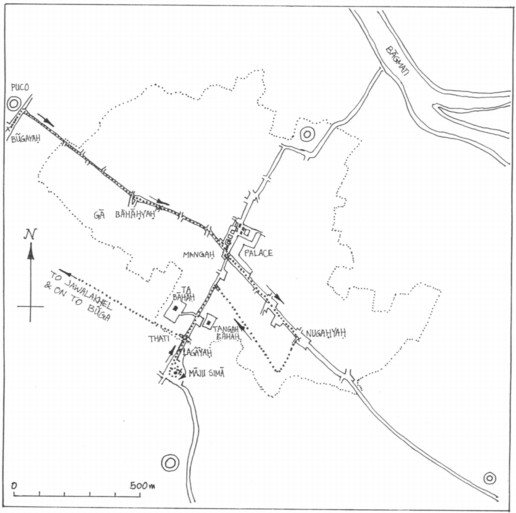
|
An enacted playThe chariot festival of Bungadyah, "the Jatra", as it is called by locals, has tremendous appeal as an enacted play. If, as Shakespeare's Jaques declared, "All the world's a stage,"[6] there are nevertheless moments, events in which the big themes of life seem to be enacted in a vivid and memorable way. The Jatra expresses a certain kind of social and moral order in which everybody has his place and all work together to ensure the festival's success. The stageThroughout the Jatra, the city space of old Lalitpur is made use of to represent the city itself.[7] The route of the chariot Jatra is unique among all the processions of Lalitpur (see map), and is typical of that of a visiting deity rather than one that resides in the city.[8] |
The propsThe chariots of Bungadyah and Cakwahdyah are built by two lineages of craftsmen - the Barahi Carpenters who construct the frame and the Yangwa Farmers who lash the structure together with vines. The chariots are virtual replicas of each other. Though the Cakwahdyah chariot is not a great deal shorter than that of Bungadyah (around two-thirds the height), it is a great deal easier to build and move. The chariots are effectively constructed of four main elements: the chassis, the platform with the shrine, the 'tower' and the wheels. Integral with the chassis is the main, curved beam that projects out at the front and rear - the dahma. The chariot runs on four wheels, each two metres in diameter, constructed from 25 separate elements (see picture). The threat of crushing by wheels is no hollow threat. As the dangerous deity Bhairava is believed to be manifested in the wheels, therefore, he must be propitiated with blood sacrifices - something not offered to Bungadyah himself. |
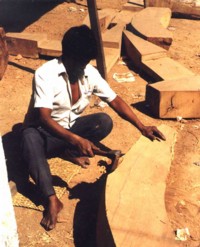
|
The play has four 'acts':
Act 1. Bunga Festival: the installation of the deity on the chariot. Early in the evening on the first day of the waxing lunar fortnight of Vaishakh, a great crowd gathers in Pulchok as the image of Bungadyah is carried on a palanquin from Ta Bahah out of the old city and installed on the chariot.
Act 2. Ga Bahah Festival: Three days after the installation of the image the chariot is pulled to Ga Bahah and the deity is worshipped by the western third of the city. From this point on, the timing of the events is controlled more by the ease with which the chariot negotiates the narrow lanes of the city and less by the calendar.
Act 3. Nugah Festival: the pulling of the chariot to Nugah (Patan Sundara) and the deity's worship by the eastern third of the city.
Act 4. Finale: Lagan Festival and the festival of Dropping the Coconut. The chariot is pulled outside the old city walls to Lagankhel. There the deity is worshipped by the middle third of the city. At the Dropping of the Coconut crowds gather as a Yangwa climbs up the tower of the chariot and after teasingly tossing sweets into the crowd finally lobs a coconut into a scrum of young men. The man who delivers the coconut to the deity is said to receive the blessing of a son.[9]
On the surface, the Jatra is all about the worship of a powerful and merciful deity who, it is hoped, will repay his devotees by bringing the monsoon rains and blessing the people with a good rice crop. But the festival can also be understood as conveying a message of conflict resolution and urban renewal and of the importance of the king in making this happen.
The Jatra comes at an anxious time for the citizens of Lalitpur. The hot dry season is at its height. The wells will soon be dry. All eyes are turned heavenward for signs of the all-important monsoon. It is vital that the monsoon produces sufficient rain for the staple crop of rice to give a decent yield. The old chronicles list many episodes of drought and famine and these exist till today in the collective memory of the Newars.[10] So the main anxiety is the constant struggle to survive against the ravages of uncontrolled nature. The myth of the coming of Matsyendranath, repeated every spring in homes across the city, expresses this very real difficulty. Ever since our first parents fell man has struggled to control the ravages of the natural world. Once Adam and Eve had rebelled, the soil would never again yield its fruit so readily. "Cursed is the ground because of you; through painful toil you will eat of it all the days of your life" (Genesis 3: 17). Famines, blights, and plagues have been common human experience ever since. But rather than come humbly to the Creator man has always wanted to tackle the problem his own way. The attempt to control nature by means of ritual is one such strategy.
|
The Jatra itself is fraught with difficulties that seem to express, in a tangible way, the more abstract anxieties of the cosmos. The chariot is huge. It needs hundreds of men to pull it. The wheels are also considerable - more than two metres across - and would crush a person in an instant if they happened to get in the way while it was moving; as has occasionally happened. Animals are sacrificed to the wheels (representing Bhairava) to prevent that happening. The tower of the chariot is also very tall. The Yangwa have the job of riding high on the tower of the chariot as it is pulled and it is not surprising to hear of one and another being killed by a fall. Three years ago, there was a surge in the crowd resulting in a devotee being pushed under the chariot and having both legs crushed. |
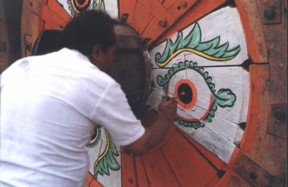
|
The chariot itself topples over completely from time to time, one year doing so three times. There are parallels here with other major festivals of the Valley. One year, at the celebration of the festival of Biskah in Bhaktapur, I witnessed the raising of the tall pole (the yahsin) from the steps of the small temple just a few feet away. The danger inherent in such operations was brought home forcefully to me the next morning when I learnt that, after I had left, the yahsin had in fact crashed onto the very steps on which I had been sitting, killing two onlookers. The following year I was watching the placement of the baymwa (the large lotus-shaped woven object) onto the top of Bungadyah's chariot. Suddenly a gasp went up from the crowd as, breaking its coupling, the half-ton construction plummeted 25m to the ground, barely missing the people.
The message of Lalitpur's great festival then goes something like this:
...admire and celebrate the civic order. That order may momentarily and frighteningly sway and lurch, but when the city works together ... it will all hold together....[11]
So there are many difficulties that the Jatra brings. But these, it could be said, are self-imposed. The chariot does not need to be so big if it is simply to carry the image. One the size of Cakwahdyah's would be more than adequate.[12] But as Levy observed, symbolic forms must be engaging. It is this engagement that gives the chariot festival its significance above any other festival in Lalitpur. The structure of the chariot must be precarious to engage the whole city in its construction and movement. It is not so much an invitation to disaster as an invitation to intense involvement. It is this engagement that binds the city together to ensure the festival's success.
The resolution of conflictThere is a curious mixture of old and new at the closing event of the festival, the Bhoto Jatra, when the bhoto (ceremonial waistcoat) is shown to the public. On the one hand there is the traditional hymn singing of the Mridanga Bhajan ensemble, the role of the Panju priests, and the keeping of the sword on the chariot. On the other there is the modern and, in some ways, ill-fitting additions of the military band, the Guthi Corporation officials, and even the present Shah king himself. Is there an echo of such conflict in the legend of the bhoto? The vest was given, goes the legend, to a farmer of Lalitpur from whom it was later stolen by a devious goblin (see side box). The subsequent fight over possession ended in a stalemate with the bhoto being taken into the care of the deity until irrefutable evidence on one side or the other was brought forward. Both the Yala Juju (i.e. the sword of the old Malla king of Lalitpur) and the Shah king return year after year to witness that the bhoto is still in the deity's possession. In the eighteenth century the Shah dynasty took over the rule of Lalitpur along with the rest of the modern nation state. The modern elements manifested at the Bhoto Jatra are clearly demonstrations of the Shah regime's intent to capture the Jatra and use it to consolidate its role as the new power. But this power is contested. The sword of the old Malla king remains on the chariot while the 'real' king stands beneath offering his puja from below. This is surely ironic and even subversive. |
The legend of the bhoto The bhoto [a vest or waistcoat-type article of clothing] once belonged to Karkotaka, the king of the nagas who lives at Taudaha pond to the south of Cobhar. Once a Jyapu vaidya cured the sore eye of Karkotaka's wife. In return Karkotaka gave the farmer his precious bhoto. One day, while the Jyapu was working in his field, a demon came and stole the bhoto that the farmer had taken off. At the time of the Jawalakhel Jatra, however, the farmer saw a tall, strange figure wearing the vest. The farmer accosted the stranger and tried to retrieve the bhoto from him. But the demon was big and a tough fight ensued. The case was taken before the king who ruled that, as there was insufficient evidence that the bhoto belonged to either party, it must be kept in the custody of Matsyendranath himself until reliable evidence was forthcoming. From the Mardaryavalokiteshvara Avadana katha. (Locke 1980: 295-6). |
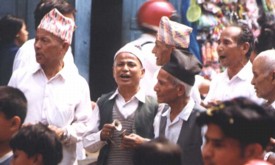
|
The fight between the farmer and the goblin can be also seen as a reflection of the ongoing conflict between the farmer and evil forces to produce fruit from the soil. The nagas can give or withhold rain and so must be placated and treated well. But apart from that they are powerless. This is plain in the origin myth when Gorakhnath sits on them to prevent rain. It takes a greater deity to release them and restore order in a situation of disintegration. And it takes that same deity to safeguard the existing order until such a time as the present conflict between man and nature, good and evil, is finally decided. It was necessary also for the king, as maintainer of order within his realm, to make that preliminary judgement. The king, however, is too human to bring such a cosmic dispute to an ultimate resolution. He must give it to the deity for safekeeping. |
The Jatra, then, works as a moral tale. There is a battle between good and evil. That is played out in the ordinary lives of people even as they go about their daily lives as farmers and artisans. The Jatra gives an opportunity to express that ritually. But why is there evil? Why is it that suffering, such as from famine, is allowed? There is a cosmic struggle going on which is not yet played out. The king cannot bring victory to the forces of good. He can only impose a certain degree of order onto the situation by calling a great deity to aid him. Karunamaya, then, ensures that disorder will not break out and wreck this unstable equilibrium. Karunamaya, then, is a saviour figure. But his salvation is material and temporal. It is not a final answer but, it is reasoned, in the kali yuga (this present evil age) one cannot expect much.
|
The Jatra is deeply connected with the founding of Lalitpur as a city. According to legend, the peasant figure, Lalita, was responsible for founding the city. Another peasant figure, Rathancakra was responsible for bringing Karunamaya to the city. David Gellner points out that, in the popular mind, the two characters are really one.[13] The founding of the city and the establishment of its most important god are, then, thought of as one event. The opening of the Jatra, like Bhaktapur's Biskah, is arranged around the spring equinox.[14] Thus it is possible to see the renewal of the city as taking place at the renewal of the year.[15] Towards the end of the Jatra (in Act 4) the chariots leave the ordered world of the city for the disordered world of the country. (It is hard for us today to imagine that Lagankhel Bus Park was an open field, very clearly outside the city up to a few decades ago.) It is here that the people who have come to embody that notion of disorder, the Dyahla Untouchables live. The exit of the deities, with the king and his retinue, from the city represents the temporary breakdown of the spatial and moral order. While the chariots are outside the city, in the field of Lagankhel, the boundary between the civilised world and the wild outside is not clear.[16] Notions of order and disorder threaten to collapse into one another. This is then another representation of the threat to the city's survival which the festival was instituted to avert. |

|
In Scripture we are told that the first builder of a city was Cain. After he murdered his brother, Cain was summoned by God and condemned to a life of wandering on the earth.
The Lord said, "What have you done? Listen! Your brother's blood cries out to me from the ground. Now you are under a curse and driven from the ground, which opened its mouth to receive your brother's blood from your hand. When you work the ground, it will no longer yield its crops for you. You will be a restless wanderer on the earth." (Genesis 4: 10-12)
Before Cain's murderous act life had gone on, outside the Garden of Eden under the Lord's protection. Life was not a garden anymore, but there was a balance between man and nature. Now that balance was shattered. Cain could no longer expect any protection from God and fully expected that an avenger would kill him. So God put a mark on Cain. It was a mark of protection. And Cain left the presence of his maker. But Cain did not wander. He would not trust the protection the Lord had given him. So he spent his life trying to find his own security, struggling against hostile forces, dominating men and nature. The natural world had become a thing of dread. God had made the natural world good (Genesis 1:4, 10, 12, 18, 21, 25, 31). But with the fall of man from his state of innocence and Cain's violence against his brother the natural world was now pitted against him. Wild animals may tear him apart. Diseases may inflict him. And so he built a city. As Jacques Ellul points out, the city is the direct consequence of Cain's murderous act and of his refusal to accept God's protection.[17]
Throughout the ages men and women have sought ways by which they can get protection from wild disordered nature. Those ways have been man-made. When man seeks his own means of protection without reference to his Creator he is declaring his independence. He has no need of God. He will get along fine by himself - autonomous man. This is the ultimate offence to God - man in his pride declaring that he can do very well without God's help. The building of the city is one of those ways. It stands for man in his pride. That urban order is constantly under threat, however, and needs to be renewed. The ritual of the Jatra is a technique that the citizens of Lalitpur have created to try to effect that renewal.
Many observers have commented on the presence of the king at the showing of the bhoto. But, as we have seen, the idea of kingship has a much more central place than this. The Shah king's presence at the Jawalakhel Jatra is not nearly so important as the centrality of the Malla king throughout the chariot's course through the city. It is my contention that the Malla king, the Yala Juju, as symbolised by his sword, is the most significant social phenomenon of the entire festival. It is the king, as much as the deity, who is the rainmaker.
Gérard Toffin explains that in a sense the king is seen as a god: "Where there is no king, assert the classical texts, rain will not fall. ...The ruler was a producer of wealth."[18] And yet he is also subject to the gods, dependent on them for legitimacy. It will be remembered that King Narendra Deva is key in the story of how Karunamaya came to the Valley in the first place. The seventeenth century King Sri Nivas Malla took this association further. For the king to be seen as the rainmaker there had to be an identification of the king with the deity. Sri Nivas adapted the Jatra so that there would be a clear identification of the monarch with Karunamaya.
The symbolism of the sword retains its power today in spite of the loss of real power to the Shah dynasty. Discussing the analogous Ram Lila festival in India, Lutgendorf reports that, by the time that the festival had reached its full month-long pageant in the early nineteenth century, real political power had passed to the British.[19] The festival had not lost its appeal however; "the symbols used to legitimate authority can serve equally well to compensate for its loss".[20] In Lalitpur, over two hundred years after his death, when the sword arrives at the Jatra, people can still be heard to say, "Sri Nivas has come!"
The idea of kingship, then, is alive and well and would be so even if Nepal became a Republic. In the enacted ritual, the ideal king is put before the people each year. The king allies himself with the deity to rescue the people from disaster. Here is, then, a pointer to the kind of saviour the people desire. The story of the incarnation and saving work of King Jesus will find a ready audience when expressed in such a way. In our attempt to tell the gospel message to our friends and neighbours we would do well to use this ritual as a point of contact.